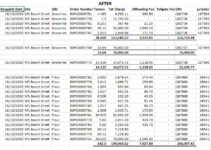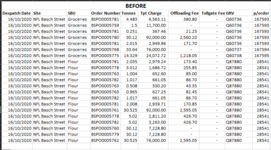I am using Office 2019 and i want to add a summation row after every last unique ref "GRV" and also the cell below the last unique reference "GRV', i want to sum totals of Columns "Tpt Charge","Offloading Fee" & "Tollgate Fee". How do i do that?
-
If you would like to post, please check out the MrExcel Message Board FAQ and register here. If you forgot your password, you can reset your password.
You are using an out of date browser. It may not display this or other websites correctly.
You should upgrade or use an alternative browser.
You should upgrade or use an alternative browser.
Inserting Summation Rows in Power Query
- Thread starter everiwa
- Start date
-
- Tags
- power query
Excel Facts
Format cells as time
Select range and press Ctrl+Shift+2 to format cells as time. (Shift 2 is the @ sign).
GraH
Well-known Member
- Joined
- Mar 22, 2020
- Messages
- 1,588
- Office Version
- 365
- Platform
- Windows
You make a second query, referring to this one and do a group by "GRV", doing the sum on those columns. Give your your totals columns the same names. Add a Custom Column with "Index" 1,000,000.
Refer again to the first query, add an Index and append the second one with the totals.
Sort on GRV and Index.
Refer again to the first query, add an Index and append the second one with the totals.
Sort on GRV and Index.
Upvote
0
GraH
Well-known Member
- Joined
- Mar 22, 2020
- Messages
- 1,588
- Office Version
- 365
- Platform
- Windows
[EDIT] Example in 1 Query, same idea, including both total now.
let
Source = Excel.CurrentWorkbook(){[Name="Table1"]}[Content],
#"Changed Type" = Table.TransformColumnTypes(Source,{{"Date", type any}, {"Site", type any}, {"SBU", type any}, {"Order", type any}, {"Tonnes", type number}, {"Tpt Charge", type number}, {"Offloading Fee", type number}, {"Tollgate Fee", type any}, {"GRV", type text}, {"p/order", type any}}),
#"Replaced Value" = Table.ReplaceValue(#"Changed Type",null,0,Replacer.ReplaceValue,{"Tonnes", "Tpt Charge", "Offloading Fee", "Tollgate Fee"}),
#"Grouped Rows" = Table.Group(#"Replaced Value", {"GRV"}, {{"Tonnes", each List.Sum([Tonnes]), type number}, {"Tpt Charge", each List.Sum([Tpt Charge]), type number}, {"Offloading Fee", each List.Sum([Offloading Fee]), type number}, {"Tollgate Fee", each List.Sum([Tollgate Fee]), type none}}),
#"Added Custom" = Table.AddColumn(#"Grouped Rows", "GRV1", each [Tonnes]+[Tpt Charge]+[Offloading Fee]+[Tollgate Fee]),
#"Added Custom1" = Table.AddColumn(#"Added Custom", "Index", each 1000000),
#"Grouped Rows1" = Table.Group(#"Added Custom1", {}, {{"Tonnes", each List.Sum([Tonnes]), type number}, {"Tpt Charge", each List.Sum([Tpt Charge]), type number}, {"Offloading Fee", each List.Sum([Offloading Fee]), type number}, {"Tollgate Fee", each List.Sum([Tollgate Fee]), type number}, {"GRV1", each List.Sum([GRV1]), type number}, {"Index", each List.Sum([Index]), type number}}),
Custom1 = #"Changed Type",
#"Added Index" = Table.AddIndexColumn(Custom1, "Index", 1, 1),
#"Added Custom2" = Table.AddColumn(#"Added Index", "GRV1", each [GRV]),
Custom2 = Table.Combine({#"Added Custom2",#"Added Custom1",#"Grouped Rows1"}),
#"Replaced Value1" = Table.ReplaceValue(Custom2,null,"ZZZ99999999",Replacer.ReplaceValue,{"GRV"}),
#"Sorted Rows" = Table.Sort(#"Replaced Value1",{{"GRV", Order.Ascending}, {"Index", Order.Ascending}}),
#"Removed Columns" = Table.RemoveColumns(#"Sorted Rows",{"GRV", "p/order", "Index"}),
#"Renamed Columns" = Table.RenameColumns(#"Removed Columns",{{"GRV1", "GRV"}})
in
#"Renamed Columns"
let
Source = Excel.CurrentWorkbook(){[Name="Table1"]}[Content],
#"Changed Type" = Table.TransformColumnTypes(Source,{{"Date", type any}, {"Site", type any}, {"SBU", type any}, {"Order", type any}, {"Tonnes", type number}, {"Tpt Charge", type number}, {"Offloading Fee", type number}, {"Tollgate Fee", type any}, {"GRV", type text}, {"p/order", type any}}),
#"Replaced Value" = Table.ReplaceValue(#"Changed Type",null,0,Replacer.ReplaceValue,{"Tonnes", "Tpt Charge", "Offloading Fee", "Tollgate Fee"}),
#"Grouped Rows" = Table.Group(#"Replaced Value", {"GRV"}, {{"Tonnes", each List.Sum([Tonnes]), type number}, {"Tpt Charge", each List.Sum([Tpt Charge]), type number}, {"Offloading Fee", each List.Sum([Offloading Fee]), type number}, {"Tollgate Fee", each List.Sum([Tollgate Fee]), type none}}),
#"Added Custom" = Table.AddColumn(#"Grouped Rows", "GRV1", each [Tonnes]+[Tpt Charge]+[Offloading Fee]+[Tollgate Fee]),
#"Added Custom1" = Table.AddColumn(#"Added Custom", "Index", each 1000000),
#"Grouped Rows1" = Table.Group(#"Added Custom1", {}, {{"Tonnes", each List.Sum([Tonnes]), type number}, {"Tpt Charge", each List.Sum([Tpt Charge]), type number}, {"Offloading Fee", each List.Sum([Offloading Fee]), type number}, {"Tollgate Fee", each List.Sum([Tollgate Fee]), type number}, {"GRV1", each List.Sum([GRV1]), type number}, {"Index", each List.Sum([Index]), type number}}),
Custom1 = #"Changed Type",
#"Added Index" = Table.AddIndexColumn(Custom1, "Index", 1, 1),
#"Added Custom2" = Table.AddColumn(#"Added Index", "GRV1", each [GRV]),
Custom2 = Table.Combine({#"Added Custom2",#"Added Custom1",#"Grouped Rows1"}),
#"Replaced Value1" = Table.ReplaceValue(Custom2,null,"ZZZ99999999",Replacer.ReplaceValue,{"GRV"}),
#"Sorted Rows" = Table.Sort(#"Replaced Value1",{{"GRV", Order.Ascending}, {"Index", Order.Ascending}}),
#"Removed Columns" = Table.RemoveColumns(#"Sorted Rows",{"GRV", "p/order", "Index"}),
#"Renamed Columns" = Table.RenameColumns(#"Removed Columns",{{"GRV1", "GRV"}})
in
#"Renamed Columns"
Last edited:
Upvote
0
shaowu459
Well-known Member
- Joined
- Apr 26, 2018
- Messages
- 734
- Office Version
- 365
- Platform
- Windows
Please try this:

VBA Code:
let
Source = Excel.CurrentWorkbook(){[Name="Table3"]}[Content],
Custom1 = Table.Combine(Table.Group(Source,"GRV",{"n",each let c=Table.ToColumns(_) in #table(Table.ColumnNames(_),Table.ToRows(_)&{{null,null,null,null}&Record.ToList([m=List.Sum(c{4}),n=List.Sum(c{5}),o=List.Sum(c{6}),p=List.Sum(c{7}),q=m+n+o+p,r=null])})})[n])
in
Custom1| 供参考.xlsx | ||||||||||||
|---|---|---|---|---|---|---|---|---|---|---|---|---|
| A | B | C | D | E | F | G | H | I | J | |||
| 1 | Despath Date | Site | SBU | Order Number | Tonnes | Tpt Charge | Offloading Fee | Tollgate Fee | GRV | p/order | ||
| 2 | 45 | 38 | 74 | 5 | Q1 | 16759 | ||||||
| 3 | 94 | 8 | 76 | 72 | Q1 | 16759 | ||||||
| 4 | 84 | 35 | 54 | 62 | Q1 | 16759 | ||||||
| 5 | 79 | 32 | 42 | 78 | Q2 | 16759 | ||||||
| 6 | 99 | 33 | 43 | 98 | Q2 | 16760 | ||||||
| 7 | 86 | 60 | 27 | 49 | Q2 | 16760 | ||||||
| 8 | 40 | 12 | 49 | 78 | Q2 | 16760 | ||||||
| 9 | 62 | 34 | 30 | 2 | Q2 | 16763 | ||||||
| 10 | 93 | 75 | 33 | 69 | Q3 | 16763 | ||||||
| 11 | 50 | 39 | 27 | 37 | Q3 | 16763 | ||||||
| 12 | Despath Date | Site | SBU | Order Number | Tonnes | Tpt Charge | Offloading Fee | Tollgate Fee | GRV | p/order | ||
| 13 | 45 | 38 | 74 | 5 | Q1 | 16759 | ||||||
| 14 | 94 | 8 | 76 | 72 | Q1 | 16759 | ||||||
| 15 | 84 | 35 | 54 | 62 | Q1 | 16759 | ||||||
| 16 | 223 | 81 | 204 | 139 | 647 | |||||||
| 17 | 79 | 32 | 42 | 78 | Q2 | 16759 | ||||||
| 18 | 99 | 33 | 43 | 98 | Q2 | 16760 | ||||||
| 19 | 86 | 60 | 27 | 49 | Q2 | 16760 | ||||||
| 20 | 40 | 12 | 49 | 78 | Q2 | 16760 | ||||||
| 21 | 62 | 34 | 30 | 2 | Q2 | 16763 | ||||||
| 22 | 366 | 171 | 191 | 305 | 1033 | |||||||
| 23 | 93 | 75 | 33 | 69 | Q3 | 16763 | ||||||
| 24 | 50 | 39 | 27 | 37 | Q3 | 16763 | ||||||
| 25 | 143 | 114 | 60 | 106 | 423 | |||||||
Sheet2 | ||||||||||||
Upvote
0
shaowu459
Well-known Member
- Joined
- Apr 26, 2018
- Messages
- 734
- Office Version
- 365
- Platform
- Windows
Yes, for beginners it is not easy to understand and apply. GUI+M function would be a better way.Rather advanced with the let inside a function and the compressed code for grouping. Impressive. Not sure if less advanced user can adopt this easily.
Upvote
0
Bo_Ry
Board Regular
- Joined
- Oct 27, 2018
- Messages
- 179
- Office Version
- 365
- Platform
- Windows
Another 1 step M-Code
Power Query:
let
Source = Excel.CurrentWorkbook(){[Name="Table1"]}[Content],
Grouped = Table.Combine(Table.Group(Source,"GRV",{"C",each let a={List.Sum([Tonnes]),List.Sum([Tpt Charge]),List.Sum([Offloading Fee]),List.Sum([Tollgate Fee])} in Table.Combine({_,#table( List.Range(Table.ColumnNames(_),4,5),{a&{List.Sum(a)}})})})[C])
in
Grouped
Upvote
0
GraH
Well-known Member
- Joined
- Mar 22, 2020
- Messages
- 1,588
- Office Version
- 365
- Platform
- Windows
Also nice one. Though one can argue it is a one line solution. It is nesting functions. According to some experts that is not always better then adding extra steps. Yet as always it depends. Might well be the case these short codes also run way faster. I did not test.
Just shows PQ offers ways that appeal to both non programmers like myself and to professionals having code writing kills like you guys being able to come up with these elegant pieces of work.
Just shows PQ offers ways that appeal to both non programmers like myself and to professionals having code writing kills like you guys being able to come up with these elegant pieces of work.
Upvote
0
Similar threads
- Question
- Replies
- 1
- Views
- 248
- Replies
- 5
- Views
- 585
- Replies
- 0
- Views
- 249
- Question
- Replies
- 2
- Views
- 359







